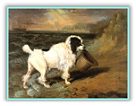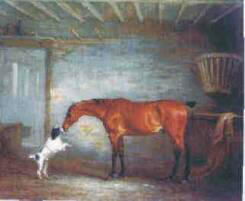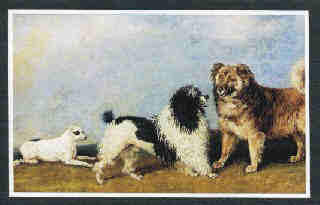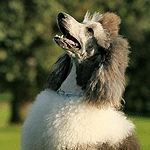PARTI POODLE HISTORY
A Parti Poodle, is a poodle that is predominately white broken with irregular patches or spots of a second colour.
Writings, drawings, and paintings from the 1700s and 1800s have many examples of the Parti Poodle.

This is a picture attributed to George Stubbs (born: 17 August 1724, died: 10 July 1806) showing that the Parti Poodle was a known breed back in the 18th Century and popular enough to be painted.
The dog standing beneath the portrait is Vulcan Champagne Polka Dot, whelped 21 June 1953 showing a documented history of well over 150 years.

For some unknown reason, around the turn of the 20th Century the parti colour became unfashionable. However, a few breeders such as the late Hon. Mrs Ionides and her partner Miss Shirley Walne continued to breed them for sheer pleasure.

In an article by Ann Cambray Coppage, (Vulcan Kennels) entitled ‘Particolour Poodle’s which appeared in the August 1977 issue of ‘Our Poodles, Salute to Britain’, Ann wrote: ‘The character of the particolours was always unique; somehow they had an extra dimension — just that bit more clever, amusing or intelligent than their solid-colour littermates.
Naturally enough, it was always they, which caught the eye of prospective purchasers — and often there was a waiting list for the next one expected’.
We are very fortunate to have Ann as our advisor in the endeavour to re-introduce the Parti Poodle to the UK. Ann was one of the last breeders to be associated with the parti coloured poodles that died out in the 1960s and 1970s.
However, despite generations of solid colour breeding, Partis can still crop up in British litters today.

Multi-coloured poodles are currently experiencing a strong comeback in the United States and the rest of the world. Within the past decade, there has been a resurgence of the Parti Poodle. Partis can be registered with both the American Kennel Club and the United Kennel Club; they may be shown in UKC conformation classes. Other countries are following suit.

In the UK Partis and Phantoms may be registered but the Kennel Club classify the colour as ‘non recognised’.
